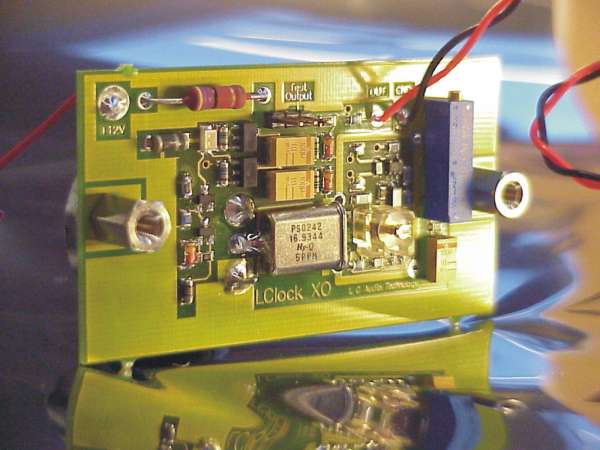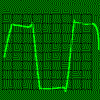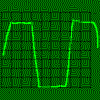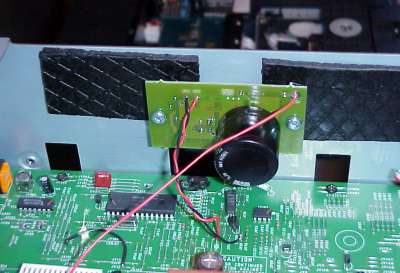LClock XO Precision CD Master Clock Generator.
Don't waste money buying a new CD player, because Your'e not satisfied with the Sound Quality of the one You already have.

This module with a precision Master Clock Generator can improve the sound quality of almost any CD player from the cheapest to the most costly. - Why?
99% of all CD players on the market are equipped with a cheap CMOS crystal Oscillator, with a high level of analog input noise. The crystal oscillator produces the reference frequency by changing state at a rate of i.e. 16.934.400 times per second. The oscillator works by making the crystal unit filter the output signal of a CMOS gate, and sending it back to the input at a phase shifted sinewave of some 100 mV amplitude. This is enough to make the gate shift states in a fairly stable manner. However as the 100 mV signal is mixed with an analog input noise of 100 uV (MicroVolts) this causes the oscillator to shift state slightly before or after it was supposed to. Since there is a ratio of 1000 between 100 mV and 100 uV, the raw signal to noie ratio can be calculated to 40 dB. At 16,9 MHz raw clock frequency the division ratio to reach the audio sampling rate of 44,1 times 8 ( 352,8 kHz ) is 48. Thus the jitter level is also attenuated by 48 times or 33 dB. The total (time domain) signal to noise ratio is then 40 + 33 or 73 dB. Not at all enough to use the DAC chips potential of some 95 - 100 dB of S/N.
The time noise is also called jitter.
Since a crystal oscillator only requires one single inverter to work,
most CD makers use the other 5 inverter gates in the 74HCU04 IC for other
purposes, such as switching and buffering. However, this causes switching
noise on the supply rails. Since the analog trigger level of a gate is
one half the VCC voltage, half of the switching noise is transferred directly
to the input of the Crystal Oscillator.
This creates even more jitter, one of the most unfreindly phenomenon
in digital audio equipment.
Sound will be harsh and Stone Cold. Sound Stage is narrow, and uninteresting,
music becomes what is known as: DIGITAL!
Lets take a look inside Your CD players control signals:
This is what the clock signal in Your CD player looks like:
Now:  ...compare with
the signal of an LClock2:
...compare with
the signal of an LClock2:
In CD's with a signal processor - integrated crystal oscillator, (Such as the SAA7345, SAA7220 or NPC SM5864) there are not only 5 other gates creating jitter, but hundreds, making the problem even worse.
CD producers like SONY, Arcam, Kenwood, Pioneer and Rotel are becoming
aware of how serious the Jitter problem really is, but still they are not
solving the problem adequately. In their 1999/2000 models these manufacturers
all use cheap CMOS or transistor oscillators with standard high-noise voltage
regulators and cheap 50 c crystal units.
We use only fine handcut precision crystals, ultra lownoise regulators
and GHz high frequency transistors for LClock2.
That makes a difference!
The LClock XO is a credit card size SMD Circuit to fit into Your CD
player, and it contains a super low jitter master clock, to replace the
existing oscillator. The time domain S/N is as high as > 120 dB, so You
are sure to exploit the full potential of Your CD players DAC system.
The XO Clock is a very cost effective way to improve the sound of almost any CD player, no matter the price level.
This is what it does to sound:
- Firmer and more distinct Bass.
- Wider, deeper and higher soundstage.
- Better definition and placement of instruments in a multiinstrument session.
- Cleans up hairy treble performance.

Here shown mounted in a Denon DCD 3000.
Technical Data Sheet:
| Frequencies | Precision | |
| 8.4672 | 2 ppm. | MHz |
| 11.2896 | 2 ppm. | MHz |
| 12.2880 | 2 ppm. | MHz |
| 16.9344 | 2 ppm. | MHz |
| 18.4320 | 2 ppm. | MHz |
| 22.5792 | 2 ppm. | MHz |
| 24.5760 | 2 ppm. | MHz |
| 27.0000 | 2 ppm. | MHz |
| 33.8688 | 2 ppm. | MHz |
| 45.1584 | 2 ppm. | MHz |
| Jitter Level | 2,5 | ps (max.) |
| Power Supply Noise | 1.8 | uV (max.) |
| Power Supply Rejection | 92 | dB (max.) |
| Power Supply Influence on Frequency | 0,01 | ppm / Volt(max.) |
| Current Consumption | 60 | mA |
| Supply Voltage Range | 9 - 26 | Volts DC |
| Thermal Performance | 10 - 50 | deg. C |
| Size | 50 by 80 | mm. |
But Maybe You don't bother with these technical terms, and - like more than 2000 other music-addicts in Scandinavia and most other places in the world - just want to get the wide musical perspective, the high definition and the firm, distingtive bass reproduction Your CD player can only offer with an LClock XO upgrade.
Remember, if You have just a little experience with electronics or have
a freind with a few skills, this would be adequate to get Your machine
upgraded to supreme performance. Its easy and it takes only 15 to 20 minutes
on most models.
Example:
In our demoroom we now have a Rotel RCD 971 and a RCD 991 - both from 1999. The first machine cost about half as much as the last one. Owing to LClock modification, and nothing else, the cheap CDP-971 outperforms the RCD 991 so convincingly that most of our visitors don't believe what they hear!Much better musicality, and crystal clean treble, firm bass and a wide
perspective is some of the qualities the CDP 971 has over the unmodified
CDP 991.
Read more:
What is the procedure for installing an LClock?How is the LClock XO installed in my particular model?
Other effective modifications to Your CD Player.
Why not upgrade the analog stage, to further improve the liquidity and musicality of Your player, especially noticable at loud or complicated sections of the music.This is done simply by replacing 1, 2, 4 or 6 operational amplifiers in the analog section of player. In almost all avalable CD players at any price tag, cheap ( 20 Cent ) IC's are used, when a little more can drastically improve sound quality.
An even more effective solution, but a higher cost is our brand new ZAPfilter, which also allows you to build a true balanced output into any CD or even DVD player.